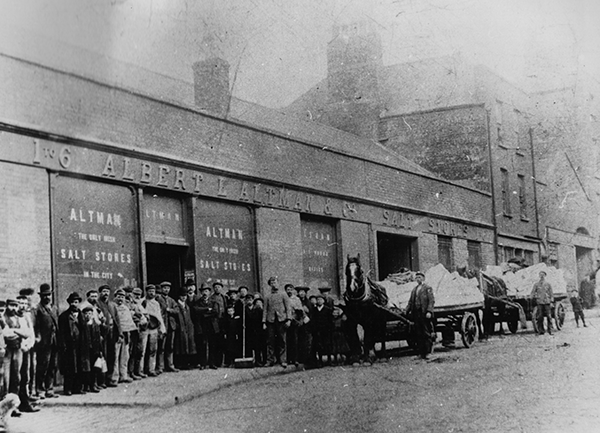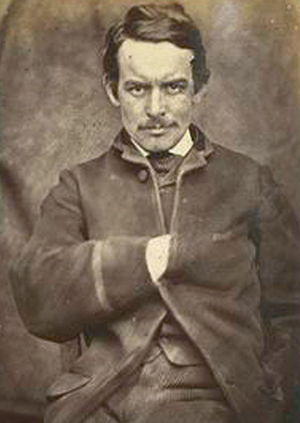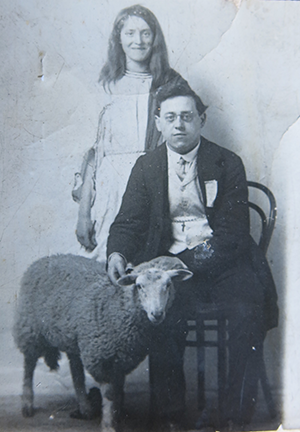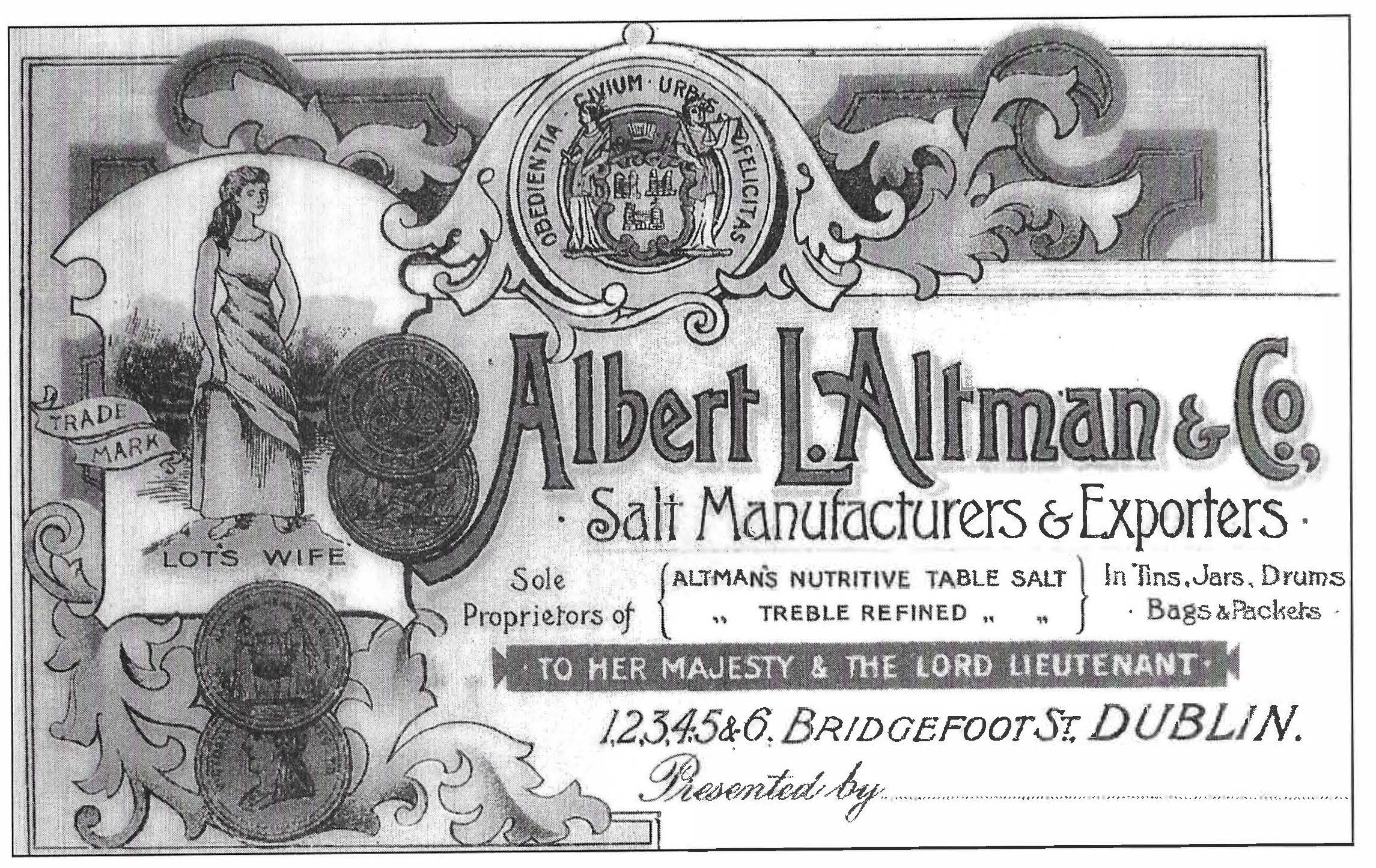‘Altman the Saltman’, Leopold Bloom and James Joyce
Published in 20th-century / Contemporary History, Features, Issue 3 (May/June 2017), Volume 25After almost a century, readers of Ulysses are still learning about how and why James Joyce created one of the most complex and provocative Jewish characters in literature.
By Vincent Altman O’Connor
While Leopold Bloom is the most renowned Irish Jew of all time, it is generally accepted that the character was modelled on Joyce’s Jewish friends in Trieste, including, most prominently, the novelist Ettore Schmitz. Could, however, the Dublin salt merchants Albert Altman (1852?–1903), his brother Mendal Altman (1860–1915) and Mendal’s son Emanuel Altman (1889–1963) have contributed parts of the composite that is the fictional Leopold Bloom?
Until recently Joyceans were unaware of the Altmans, although they have been documented in many publications, the latest being Joe Duffy’s Children of the Rising. In conversation with the writer, former Taoiseach Liam Cosgrave recalled his father, W.T. Cosgrave, speaking fondly of ‘Altman the Saltman’ of Usher’s Island. Padraic Colum opined that James Joyce did not know any of Dublin’s Jewish community. Nonetheless, as an avid reader of newspapers Joyce could not but have been aware of the Altmans, who were Dublin’s leading Jewish politicians. While Ireland’s Jews were, by and large, pro-Empire, the Altmans were notable exceptions: they were Irish nationalists.

Above: Albert L. Altman & Co. Salt Stores, 1–6 Bridgefoot Street, c. 1895, opposite St Catherine’s Church, Thomas Street, where Robert Emmet was executed in 1803. Emmet was a preoccupation of Leopold Bloom’s in Ulysses.
The Invincibles
James Fairhall suggests that ‘the Phoenix Park murders lie at the centre of Ulysses’, and readers are often mystified by Bloom’s muddled thoughts on James Carey and the Invincibles. In 1881 the Altmans were associates of Carey in the Irish Home Manufacturers’ Association, and during the trial the Invincible Joe Brady cited Altman in his evidence. After Brady was hanged, his brother James fled to Paris, where he associated with the Fenian Joseph Casey, a cousin of the movement’s founder, James Stephens. Casey was an acquaintance of John Joyce, and during his son’s sojourn in Paris the impoverished writer dined with and borrowed money from ‘Casey the Fenian’. In 1909 another Invincible, James Mullet, attended the funeral of Mary Ellen Callanan, a cousin of Joyce and the model for Mary Jane in his short story ‘The Dead’. The Callanans lived at 15 Usher’s Island, near Altman’s imposing residence at 11 Usher’s Island, and in 1896 Mullet supported Altman in his bid to be elected to Dublin Corporation. David Sheehy MP, a close friend of the Joyces, was a frequent visitor to the Altman house.

Above: Denis F. Burke, a member of the IRB Military Council, who masterminded the famous escape of James Stephens in 1865. In Ulysses ‘the man that got away, James Stephens’, is never far from the thoughts of Leopold Bloom. Intriguingly, Susan O’Reilly, wife of Albert Altman, was Burke’s cousin.
James Stephens and the Fenians
Lily Kierans, a member of the extended Altman family and a friend of Maude Gonne, claimed that Albert Altman was occasionally referred to as the ‘Jewish Fenian’, a sobriquet coined by Barrow Belisha, who is opaquely cited in Finnegans Wake. Readers of Ulysses will recall that Leopold Bloom’s political views were inspired by, amongst others, Lalor, Mitchel, Parnell and Davitt, but ‘the man that got away, James Stephens’, is never far from his thoughts. Intriguingly, Susan O’Reilly, Albert’s wife, was a relative of Denis F. Burke, a member of the IRB Military Council, who masterminded the cunning escape of Stephens from prison in 1865.
John O’Hanlon, later parish priest of the Star of the Sea Church in Sandymount, had officiated at Stephens’s wedding, and before his capture Stephens lived at ‘Fairfield’, Newbridge Avenue, a house later occupied by Philip McCann, godfather to James Joyce. In Ulysses, Paddy Dignam lived at 9 Newbridge Avenue.
The Altmans’ activities in the Land League were widely reported, and William Morris, the libertarian Marxist, noted Albert’s membership of the Irish Labour League. The brothers were also shareholders in the Freeman’s Journal and, together with the Fenian John Kelly, were pivotal in the release from prison of tenant Thomas Moroney. Ellmann and Costello have suggested that Kelly, also a member of the Irish Home Manufacturers’ Association and godfather to Florence Joyce, is the model for Mr Casey in Portrait of the artist as a young man.
Arthur Griffith and Sinn Féin
In 1896 Altman’s manifesto was published in The Nation. It prefigures that of Sinn Féin yet there is no evidence to suggest that the Altmans were involved in the party’s formation. According to Emanuel, the family was distressed by Arthur Griffith’s early anti-Semitism.
These were tumultuous years for the Jewish community, as they struggled to come to terms with the demand for Home Rule. Councillor Mendal Altman facilitated a meeting in the Mansion House of the Judeo-Irish Home Rule Association, whose secretary was the controversial Joe Edelstein, but, as might have been predicted, the gathering ended in a fist fight. Jane Edelstein, a descendant, informed the writer that Joyce and Edelstein were acquainted.

Above: This photo of Emanuel Patrick Columbanus Altman (1889–1963), Albert’s nephew, who, like Bloom, worked in Dublin’s Cattle and Sheep Market, was taken in the City Arms Hotel, where Leopold and Molly Bloom once resided. (Name of the sheep and the young woman unknown.)
maIn 1901, after many unsuccessful attempts, Albert was elected to Dublin Corporation, where he represented the Usher’s Quay ward. He was succeeded by Mendal in 1907. Although the Altmans were members of the United Irish League, they were supported by the Labour Electoral Association, much to the chagrin of John Redmond. Albert’s political ally was the prominent Sinn Féiner Alderman Thomas Kelly. Kelly was one of the chief mourners at Albert’s funeral and, as we know from his letters, Joyce was familiar with Kelly’s political activities. Kelly lived at 23 Longwood Avenue, which abutted the birthplace of Leopold Bloom at 52 Upper Clanbrassil Street.
In Ulysses the Citizen, an alcoholic land-grabber, abuses Leopold Bloom, yet John Wyse reminds the barflies that ‘Bloom gave the idea for Sinn Féin to Griffith’. Joyce’s assertion that the temperate Bloom is the inspiration for Sinn Féin has confounded scholars and has resulted in many fanciful interpretations. Once ‘Altman the Saltman’ is factored into the equation, the confrontation between the Citizen and Bloom takes on a fresh vitality. In the 1970s, the Joyce scholar Hugh Kenner stumbled across a rumour in Dublin which suggested that Griffith had ‘a Jewish advisor-ghost writer’, but he was unable to identify Griffith’s mysterious Jewish mentor.
‘Ivy Day’
Mendal Altman shared a house in Queen’s Street with a Joe Hynes, who appears as a character in Joyce’s short story ‘Ivy Day in the Committee Room’ and in Ulysses. Mendal also had an address at 12 Saint Kevin’s Parade, but the family eventually settled in 28 Arbour Hill, Stoneybatter. In an obvious coded allusion, Joyce locates Moses Herzog, the moneylender, at 13 Saint Kevin’s Parade and Geraghty, the debtor, at 29 Arbour Hill.
During the municipal elections of 1902, both Albert Altman and James Connolly were endorsed by Griffith in the United Irishman. Emanuel Altman claimed that John Joyce canvassed for Albert ‘to return a favour’, and Charlie Joyce confirmed that his family was, indeed, in debt to an individual known cryptically as ‘the man at the top’.
In 1903 Albert Altman and Alderman Kelly voted against an address of welcome to King Edward VII. Some years later, Mendal was assaulted by the DMP as he and Dick Carroll (Richard O’Carroll) entered City Hall to vote against an address of welcome to King George V. Councillor Carroll, a Poor Law guardian, was secretary of the Bricklayers’ Union and a founder member of the Irish Labour Party. He was elected to Dublin Corporation in 1907 but was murdered by Captain Bowen-Colthurst in 1916. Carroll may be the model for the off-stage character of ‘Colgan’ in ‘Ivy Day’.
The scandal of 1903
In 1896 Albert Altman claimed that Dublin’s Lord Mayor M’Coy was dilatory in paying his rates. Questions were asked as to how Albert had acquired such confidential details from the Rates Office, but he was unwilling to identify the clerk from whom he received the information. Reference was made to the rates books of 1893, the year in which John Joyce had been dismissed from the Rates Office in controversial circumstances. In what the press described as a ‘crushing defeat for the Lord Mayor’, the case brought ‘Altman the Saltman’ once more to the attention of the Irish public, and his part in the downfall of M’Coy would not be forgotten. In Ulysses, Bloom has little time for the character M’Coy and considers him dishonest.
aAlso in Ulysses, the enigmatic Mrs Emily Sinico dies in Sandymount on 14 October 1903, the very day when it was reported that Albert Altman, yet again, accused members of the Corporation of being tardy in paying their rates. As the Irish Times headlines screamed ‘Altman’s Revelations’ and ‘Corporation Scandal’, the Rates Office was besieged by lawyers attempting to regularise their clients’ affairs. While Dubliners held their breath in anticipation of further revelations, ‘Altman the Saltman’ was reported dead. With memories of Lord Mayor M’Coy still topical, this sensational affair and Altman’s sudden demise set Ireland alight with rumours which lasted until the 1960s.
The route taken by Albert’s funeral to Glasnevin Cemetery is almost identical to that of Paddy Dignam’s, and Altman’s grave is a few metres from that of Matthew Kane, on whom Dignam is partially based. The saltman rests with his wife Susan, his son Bertie, who died in infancy, and their only daughter, Mimi. Readers of Ulysses will recall that Rudy is Bloom’s son who also died in infancy, and their only daughter is Milly. The late Shane MacThomais, historian at Glasnevin Cemetery, remarked that the fictional grave of the Blooms is almost indistinguishable from the factual grave of the Altmans.
‘Am I walking into eternity along Sandymount Strand?’
Shortly after Albert’s second marriage, his daughter Mimi (1884–1943) left the family home in Pembroke Road. Mimi, a beautiful young woman of independent means, was a talented singer and pianist and, notwithstanding her schooling at Loreto on the Green, was known as the ‘Jew’s daughter’. In 1902 she moved to 35 Strand Road, a few metres from Sandymount Strand. Next door would become the residence of James and Gretta Cousins, where Joyce spent the night of 16 June 1904, and persistent rumours in the Altman family suggest that Mimi spurned the advances of James Joyce. Mimi is undoubtedly part of the composite that is Emma Clery, the muse of Stephen Dedalus, Joyce’s literary alter ego.
Until the papal ban on female choristers, Mimi sang in the choir at the Star of the Sea Church, Sandymount, where Canon O’Hanlon had offered Joyce the position of tenor, which he declined in favour of his brother Charlie. After her father’s death, Mimi was consoled at Strand Road by her cousins Cissy (1880–1956) and Edy (1885–19??), daughters of Mendal. In Ulysses, Bloom observes Cissy (Caffrey) and Edy (Boardman) on Sandymount Strand as Canon O’Hanlon celebrates Benediction for the Temperance retreat in the Star of the Sea Church nearby.

Calling card for ‘Albert L. Altman & Co., Salt Manufacturers & Exporters’. Note ‘Lot’s wife’ (to the left), a minor motif in Ulysses.
Dublin’s Cattle Market
Cissy and Edy’s brother, Albert Joseph (1881–1949), had known Joyce in O’Connell’s Schools, and another brother, Emanuel, an expert on foot-and-mouth disease, worked at Dublin’s Cattle and Sheep Market as a health and sanitation inspector. His great adversary was Mr Cuffe, the cattle dealer who was once Leopold Bloom’s employer, and Emanuel recalled many a stormy confrontation with Cuffe in the City Arms Hotel, where Leopold and Molly once resided.
In the 1960s the writer John D. Sheridan, a conservative Catholic, implored Emanuel to read Ulysses. Sheridan had been animated by the case of Ruben J. Dodd, who won damages in Dublin’s High Court when the BBC broadcast excerpts from the novel. Sheridan advised Emanuel to take legal advice but Emanuel had no interest in Joyce’s ‘smutty book’. It later emerged that Sheridan had been in correspondence with a Sister Mary Gertrude in New Zealand. She was Margaret Alice, known as ‘Poppie’, a sister of James Joyce. Recently, Seán Latham opined that ‘if Bloom had some sort of clear historical antecedent or even some tenuous connection could be drawn to a living person, then the grounds for a defamation suit would have been quite strong, particularly since the text delves so deeply into his sexual habits and private thoughts’.
Emanuel, who lived in Phibsborough, recalled how he would meet John Joyce in Brian Boru House. He considered ‘old Joyce’ a ‘decent chap’ but added, sotto voce, ‘My sister Cissy who knew the Joyce girls heard he was a brute’. Speaking of the the part played by his family in the Irish separatist movement, Emanuel said ruefully, ‘The Altmans never got the credit because they were Jewish and nobody remembers them now’.
The Altmans were one of Ireland’s most important twentieth-century Jewish families. They made their political impact on the city of Dublin during the era when its most renowned son and author was on the cusp of creating some of the century’s greatest literary works. Joyce’s entire canon owes much of its raw material to the indelible memories of his formative years in Dublin. We might say that, as part of those memories, Leopold Bloom would not be the same character without the mental portrait of ‘Altman the Saltman’ that Joyce took with him to the Continent in 1904.
Vincent Altman O’Connor is a civil servant in the Department of Agriculture, Food and the Marine.
Read More:
In the beginning . . .
Some members of the Altman family disagree with a number of the points raised in the above article. To facilitate this debate an annotated version of the article as it appeared in the magazine canviewed/downloaded here, along with a further comment from the author. Click here AtlmanDiscussion
FURTHER READING
L. Crispi, Joyce’s creative process and the construction of characters in Ulysses: becoming the Blooms (Oxford, 2015).
N.R. Davison, James Joyce, Ulysses and the construction of Jewish identity (Cambridge, 1996).
N.R. Davison, V. Altman O’Connor & Y. Altman O’Connor, ‘“Altman the Saltman” and Joyce’s Dublin: new research on Irish-Jewish influences in Ulysses’, Dublin James Joyce Journal 6/7 (2013–14).
J. Wyse Jackson & P. Costello, John Stanislaus Joyce (London, 1997).
















